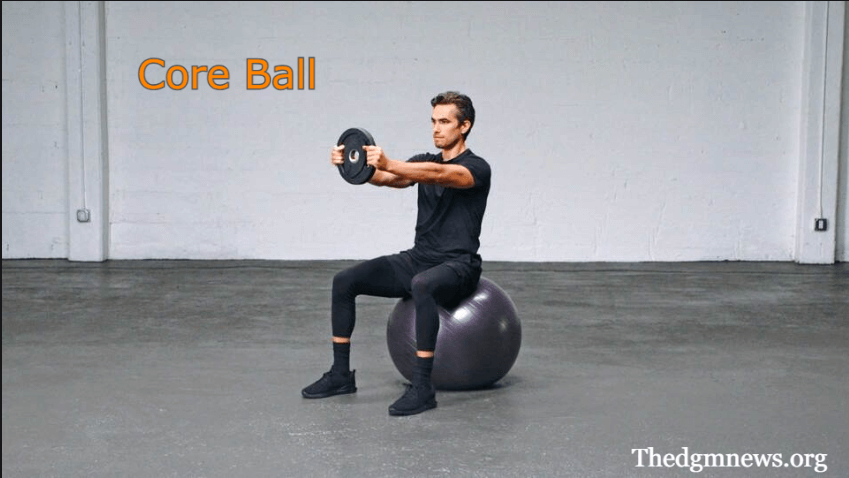Introduction
If you’ve stepped into a gym recently or scrolled through fitness trends online, chances are you’ve seen a core ball — also known as a stability ball, exercise ball, or Swiss ball.
This versatile piece of equipment has evolved from physical therapy rooms into a must-have for fitness enthusiasts, athletes, and even office workers seeking better posture.
But what exactly makes the core ball so effective? How does it benefit the body beyond the basic crunch? And can it replace your traditional gym workout?
This guide explores everything you need to know about the core ball, from how it works to how you can use it safely and effectively to achieve real results.
What Is a Core Ball?

A core ball is a large, inflatable exercise ball made from durable, anti-burst material. It typically ranges in diameter from 45 to 85 centimeters, depending on the user’s height. Originally used in rehabilitation, core balls are now utilized in a wide range of settings:
- Physical therapy and rehab
- Strength and conditioning
- Yoga and Pilates
- Home workouts
- Office ergonomics
Core Ball vs. Stability Ball vs. Swiss Ball
These terms are often used interchangeably. Here’s a quick comparison:
| Term | Common Use | Key Features |
| Core Ball | Fitness and core training | Emphasizes core stability and strength |
| Stability Ball | General term | Focuses on balance and functional movement |
| Swiss Ball | Rehabilitation | Originated in therapy; still used in physiotherapy |
Benefits of Using a Core Ball
Incorporating a core ball into your routine offers a variety of science-backed benefits, many of which go beyond simply strengthening your abdominal muscles.
1. Improved Core Stability
The ball challenges your core muscles to stabilize your body, enhancing your:
- Abdominal strength
- Lower back endurance
- Pelvic control
2. Better Balance and Coordination
Working out on an unstable surface activates small stabilizer muscles that often go underutilized in machine-based workouts.
3. Enhanced Posture and Spinal Alignment
Sitting on a core ball instead of a chair encourages upright posture, helping reduce slouching and back strain.
4. Increased Flexibility and Mobility
Many core ball stretches improve spinal mobility, hip flexibility, and overall joint range of motion.
5. Full-Body Engagement
From glutes to shoulders, core ball exercises recruit multiple muscle groups, making them excellent for compound training.
Choosing the Right Core Ball Size
Choosing the correct ball size is crucial for safety and effectiveness. Here’s a general sizing chart:
| Your Height | Ball Diameter |
| Under 5’0″ | 45 cm |
| 5’1″–5’8″ | 55 cm |
| 5’9″–6’2″ | 65 cm |
| 6’3″–6’7″ | 75 cm |
| Over 6’8″ | 85 cm |
Tip: When sitting on the ball, your knees should be at a 90-degree angle or slightly lower than your hips.
How to Use a Core Ball Effectively
1. Warm Up First
Always begin with 5–10 minutes of light cardio and dynamic stretching.
2. Engage the Core
Maintain a neutral spine and engage your abdominal muscles during all movements to avoid injury and maximize benefits.
3. Progress Gradually
Start with basic exercises and increase difficulty as your stability improves.
Top Core Ball Exercises for All Levels
Below is a breakdown of essential core ball exercises by difficulty level:
Beginner Core Ball Exercises
1. Seated March
- Sit on the core ball, feet flat.
- Lift one foot at a time while maintaining balance.
2. Wall Squats with Core Ball
- Place the ball between your back and a wall.
- Perform slow, controlled squats.
Intermediate Core Ball Exercises
3. Ball Bridge
- Lie on your back with your feet on the ball.
- Lift your hips into a bridge position, engaging the glutes
4. Core Ball Crunch
- Lie back on the ball with feet grounded.
- Perform a crunch without pulling on your neck.
Advanced Core Ball Exercises
5. Pike Roll-Out
- Start in a plank position with your feet on the ball.
- Use your core to lift your hips upward into a pike.
6. Jackknife
- Roll the ball in toward your chest while maintaining plank form.
Safety Tips When Using a Core Ball
- Use the right size based on your height.
- Check the ball’s weight limit and inspect for damage before use.
- Avoid slippery surfaces to prevent accidental rolling.
- Keep your movements slow and controlled to maintain your balance and stability.
- Don’t bounce unless specifically directed in a dynamic exercise.
Core Ball in Office and Rehabilitation Settings
Core Ball for Office Use
Swapping your chair for a core ball can:
- Encourage active sitting
- Improve spinal posture
- Engage core muscles subtly during long work hours
Core Ball for Rehab
Physical therapists use core balls for:
- Post-surgery recovery
- Lower back pain relief
- Neurological rehabilitation (e.g., stroke patients)
Real-World Applications of Core Ball Training
- Athletes use core balls to build explosive strength and injury resilience.
- Seniors perform balance drills to prevent falls.
- Pregnant women use core balls for gentle stretching and to engage their pelvic floor.
- Children benefit from playful, guided motor skill development.
How to Maintain and Store a Core Ball
- Keep away from sharp objects and heat.
- Clean regularly with mild soap and water.
- Deflate slightly for long-term storage.
- Avoid over-inflating, which could lead to bursting.
Common Mistakes to Avoid
- Using the wrong size ball
- Holding your breath during exercises
- Relying on momentum instead of muscle contro
- Arching the lower back excessively
- Not engaging the core fully during movements
Conclusion
The core ball is more than just a trendy gym accessory—it’s a powerful, science-backed tool that promotes functional fitness, improved posture, injury prevention, and core strength. Whether you’re a beginner or an elite athlete, this inexpensive and portable tool can supercharge your workout
By integrating the core ball into your daily routine, you’re not just building abs—you’re building balance, control, and confidence in every movement.



